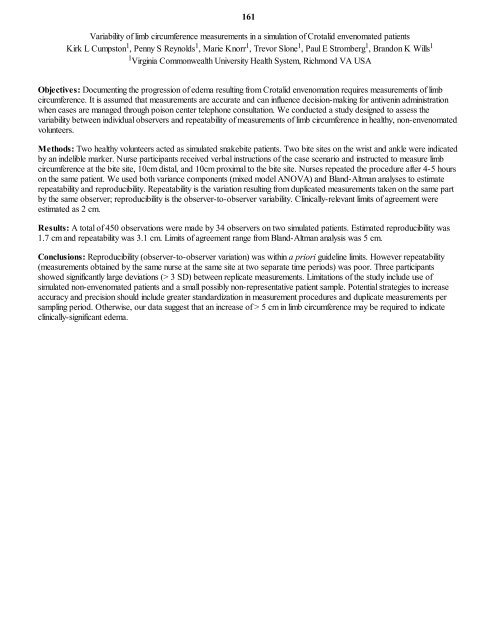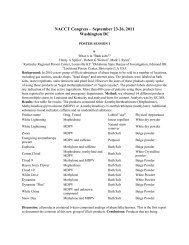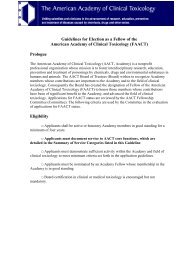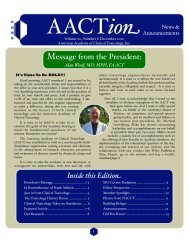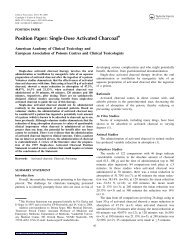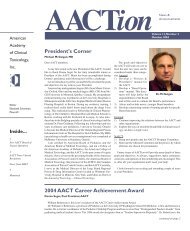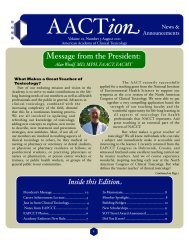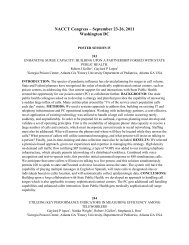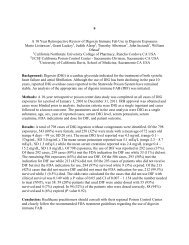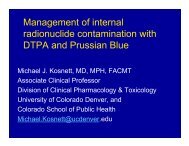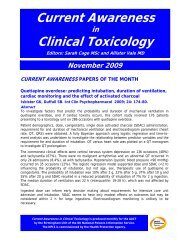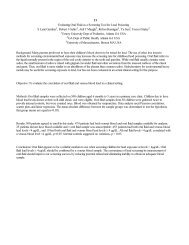NACCT Platform Abstracts 2012 - The American Academy of Clinical ...
NACCT Platform Abstracts 2012 - The American Academy of Clinical ...
NACCT Platform Abstracts 2012 - The American Academy of Clinical ...
Create successful ePaper yourself
Turn your PDF publications into a flip-book with our unique Google optimized e-Paper software.
161<br />
Variability <strong>of</strong> limb circumference measurements in a simulation <strong>of</strong> Crotalid envenomated patients<br />
Kirk L Cumpston 1 , Penny S Reynolds 1 , Marie Knorr 1 , Trevor Slone 1 , Paul E Stromberg 1 , Brandon K Wills 1<br />
1 Virginia Commonwealth University Health System, Richmond VA USA<br />
Objectives: Documenting the progression <strong>of</strong> edema resulting from Crotalid envenomation requires measurements <strong>of</strong> limb<br />
circumference. It is assumed that measurements are accurate and can influence decision-making for antivenin administration<br />
when cases are managed through poison center telephone consultation. We conducted a study designed to assess the<br />
variability between individual observers and repeatability <strong>of</strong> measurements <strong>of</strong> limb circumference in healthy, non-envenomated<br />
volunteers.<br />
Methods: Two healthy volunteers acted as simulated snakebite patients. Two bite sites on the wrist and ankle were indicated<br />
by an indelible marker. Nurse participants received verbal instructions <strong>of</strong> the case scenario and instructed to measure limb<br />
circumference at the bite site, 10cm distal, and 10cm proximal to the bite site. Nurses repeated the procedure after 4-5 hours<br />
on the same patient. We used both variance components (mixed model ANOVA) and Bland-Altman analyses to estimate<br />
repeatability and reproducibility. Repeatability is the variation resulting from duplicated measurements taken on the same part<br />
by the same observer; reproducibility is the observer-to-observer variability. <strong>Clinical</strong>ly-relevant limits <strong>of</strong> agreement were<br />
estimated as 2 cm.<br />
Results: A total <strong>of</strong> 450 observations were made by 34 observers on two simulated patients. Estimated reproducibility was<br />
1.7 cm and repeatability was 3.1 cm. Limits <strong>of</strong> agreement range from Bland-Altman analysis was 5 cm.<br />
Conclusions: Reproducibility (observer-to-observer variation) was within a priori guideline limits. However repeatability<br />
(measurements obtained by the same nurse at the same site at two separate time periods) was poor. Three participants<br />
showed significantly large deviations (> 3 SD) between replicate measurements. Limitations <strong>of</strong> the study include use <strong>of</strong><br />
simulated non-envenomated patients and a small possibly non-representative patient sample. Potential strategies to increase<br />
accuracy and precision should include greater standardization in measurement procedures and duplicate measurements per<br />
sampling period. Otherwise, our data suggest that an increase <strong>of</strong> > 5 cm in limb circumference may be required to indicate<br />
clinically-significant edema.


